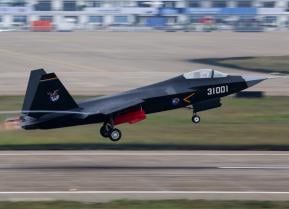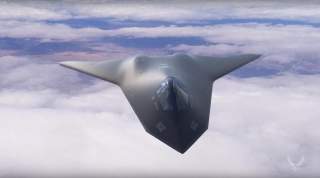Beyond the F-22 or F-35: What Will the Sixth-Generation Jet Fighter Look Like?
Lasers, Drone Swarms, Artificial Intelligence, Sensor Fusion and Optionally-Manned. Oh my!
The American development and deployment of Fifth-Generation stealth aircraft like the F-35 Lightning is one of the central stories of today’s security zeitgeist. But behind the scenes, several countries are already looking ahead to the design of a Sixth-Generation jet.
The relentless pace of research is arguably driven less by combat experience—of which there is little—and more by a sober assessment that development of a successor will take multiple decades and is better started sooner rather than later.
The Sixth-Generation fighter developers can be divided into two categories: the United States, which has developed and deployed two stealth fighter types, and countries that have skipped or given up on their attempt to build Fifth Generations jets. These latter countries have concluded that doing so is so time-consuming and expensive that it makes more sense to focus on tomorrow's technology than try to catch up with today's.
Recommended: Why an F-22 Raptor Would Crush an F-35 in a 'Dogfight'
Recommended: Air War: Stealth F-22 Raptor vs. F-14 Tomcat (That Iran Still Flies)
Recommended: A New Report Reveals Why There Won't Be Any 'New' F-22 Raptors
The latter include France, Germany and the United Kingdom, which are in the preliminary stages of developing sixth-generation FCAS and Tempest fighters; Russia, which has given up on developing its Su-57 stealth fighter for at least a decade, but is talking up a conceptual sixth-generation MiG-41 interceptor; and Japan, which is contemplating a domestic sixth-generation F-3 stealth jet, but may settle for a foreign-inspired fifth generation design.
Currently, the United States has two projects: the Air Force's ‘Penetrating Counter-Air'—a long long-range stealth fighter to escort stealth bombers—and the Navy's FA-XX. So far, Boeing, Lockheed-Martin, and Northrop-Grumman have unveiled sixth-generation concepts.
Furthermore, a third set of countries, notably including India and China, are still refining the technology for the manufacture of fourth and fifth-generation aircraft.
Stealth and Beyond-Visual Range Missiles Are Here to Stay
The various Sixth-Generation concepts mostly feature many of the same technologies. Two critical characteristics of Fifth-Generation fighters will remain centrally important to the Sixth: stealthy airframes and long-range missiles. As cost-effective ground-based air defense systems like the S-400 can now threaten vast swathes of airspace, stealth aircraft need to be capable of penetrating ‘anti-access/area-denial’ bubbles and eliminate air defense from a safe distance. Additionally, stealth jets also steeply out-perform non-stealth aircraft in aerial war games.
Thus, low radar cross-sections and radar-absorbent materials will be a necessary, but not sufficient, feature of sixth-generation fighters. Some theorists argue that stealthy airframes may eventually be rendered obsolete by advanced sensor technology—and stealthy airframes can’t be upgraded as easily as avionics and weapons. Therefore, jamming, electronic warfare, and infrared obscuring defenses will also rise in importance.
Beyond-visual-range missiles will remain a key technology. Extent missiles like the AIM-120D can already hit targets over one hundred miles away, but realistically must be fired much closer to have a good chance of a kill against an agile, fighter-sized target. However, new ramjet-powered high-speed air-to-air missiles like the British Meteor and Chinese PL-15 point to why future air warriors may mostly fight at great distances from their adversaries.
Awesome ‘X-Ray-Vision’ Pilot Helmets
The F-35 has pioneered sophisticated Helmet Mounted Displays that can see ‘through’ the airframe for superior situational awareness, display key instrument data, and target missiles via a Helmet Mounted Sight (although that last technology is decades old). Though these helmets currently have significant teething issues, they will likely become a standard feature in future fighters, possibly supplanting cockpit instrument panels. Voice-activated command interfaces may also ease the hefty task-load expected of fighter pilots.
Larger Airframes, More Efficient Engines
As airbases and carriers become more vulnerable to missile attacks, warplanes will need to be able to fly longer distances, and carry more weapons while doing so—which is difficult when a stealth jet must rely solely on internal fuel tanks and weapons loads. The natural solution is a larger plane. As air forces expect Within-Visual-Range aerial dogfights to be rare and possibly mutually suicidal, they are showing a greater willingness to tradeoff maneuverability to emphasize high sustainable speeds and a greater payload.
These design imperatives may gel well with the development of advanced adaptive g variable-cycle engines that can alter their configurations mid-flight to perform better at high speeds (like a turbojet) or more fuel-efficiently at low speeds (like a high-bypass turbofan).
Optionally-Manned
For several decades air power theorists have forecast a transition to crewless combat jets which won't have to bear the added weight and risk to life and limb necessitated by a human pilot. However, while drone technology has proliferated by leaps and bounds in that time, navies and air forces have been slow to explore pilotless fighters, both because of the expenses and risks, but also likely for cultural reasons. For example, U.S. Navy pilots successfully lobbied to re-purpose a planned carrier-based stealth attack drone into a tanker to refuel manned aircraft.
Sixth Generation concepts are therefore advancing the idea of an optionally-manned aircraft that can fly with or without a pilot onboard. This has the shortcoming of requiring additional design effort to produce an airplane that will still have the downsides and expensive training requirements of a manned airplane. However, optional-manning may help ease the transition to an unmanned fighter force, and on the short term give military leaders the possibility of deploying aircraft on high-risk missions without risking pilots’ lives.
Sensor Fusion with Friendlies on the Ground, Sea, Air and Space
One of the F-35's key innovations is its ability to soak up sensor data and share it via datalinks to friendly forces, creating a composite ‘picture.' This could allow a stealth aircraft to ride point and ferret out adversaries, while friendly forces maneuver into advantageous positions and sling missiles from further back without even turning on their radars.
Because this tactic promises to be such a force multiplier, fused sensors and cooperative engagement will become a standard feature of sixth-generation jets—and the fusion will likely be deepened by integrating satellite and even drones deployed alongside jet fighters.
Cyber Warfare and Cyber Security
Sensor fusion and optional-manning, however, imply that sixth generation jets will rely heavily on datalinks and networks which could be disrupted by jamming or even invaded through hacking. Ground-based logistics networks, such as the F-35’s ALIS, promise significant improvements in efficiency, but also expose even landed aircraft to potential cyberattack.
Thus, sixth-generation avionic systems not only must be designed for resilience versus electronic and cyber warfare—but may be capable of launching such attacks on adversaries. For example, the Air Force has successfully tested the ability to invade networks and insert data packets (such as viruses), a capability of the Navy’s fighter-borne Next Generation Jammer.
Artificial Intelligence
One problem is that all of these sensor, communication and weapons systems have become so complex that they threaten to exceed the task-processing ability of the human brain—remember, the pilot also has to fly the plane! While some Fourth-generation jets incorporated a back-seat Weapon Systems Officer to help out, Fifth-Generation stealth fighters have all been single-seaters.
Thus, air forces are turning to AI to handle more mundane tasks of fighter management and determine which data should be presented to the pilot. Furthermore, AI and machine learning may be used to coordinate drones.
Drones—and Drone Swarms
In October 2016, two FA-18 Super Hornet deployed 103 Perdix drones in a test over China Lake (you can watch the video here). Animated by an AI hivemind, the drones swarmed down like a cloud of locusts over a designated target point. Kamikaze drones have already been used in action, and it is easy to see how relatively small and cheap drones could become a particularly terrifying weapon.
Theorists of future warfare posit that inexpensive and expendable networked drones may prove far more difficult to defend against than a small number of costly and well-protected weapons platforms and missiles. However, sixth-generation fighters will likely also work with larger, faster and fancier drones to serve as sensor-bearing scouts, weapons platforms, and decoys.
Directed Energy Weapons
Swarms of drones, missiles, and even obsolete jet fighters can threaten to over-saturate an advanced stealth jet’s offensive and defensive capabilities. One commonly cited countermeasure may be Directed Energy Weapons (DEWs) such as lasers or microwaves, which can be fired quickly, precisely and with a nigh-limitless magazine capacity given sufficient electricity.
The U.S. Air Force envisions three categories of airborne DEWs: lower-powered lasers for disrupting or damaging enemy sensors and seekers, a mid-level tier capable of burning incoming air-to-air missiles out of the skies, and high-power class capable of destroying aircraft and ground targets. The air warfare branch plans to test an anti-missile laser turret in the early 2020s which may eventually be installed on bombers and F-35s.
Sixth-generation fighter programs remain strictly conceptual today, especially given the enormous expenses and effort devoted to working out the kinks in the Fifth-Generation. Many of the component technologies such as lasers, cooperative engagement, and unmanned piloting, are already in well under development, but integrating them into a single airframe will still prove a significant challenge.


